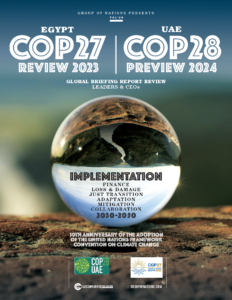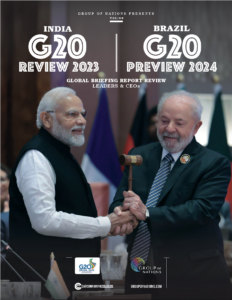G7 2018 CANADA REPORT
MAY 2018
Read and Share
Cover Story: Women in Finance – Embracing a Female Future.
22nd Annual Global Briefing Report This 3rd special edition that was published for the Canadian G7 host committee.
It has been exactly eight years since we were in Canada for a G Summit. In 2010, our team covered two back-to-back important events: the G8 Summit in Muskoka and the G20 Summit in Toronto.
At the time, a commentator for our publication described the end of the G8 Muskoka Summit as such: “The Muskoka G8 Summit is likely to be the last G8, a victim of the financial crisis and a global shift eastward as the G20 becomes the premier global economic forum.” A bold prediction, given that the G8 had been a mega event attracting more than 5,000 members of the media, civil society, and business leaders. And hundreds of thousands of activists. The end of the G8 did come, but not quite how it was predicted. It wasn’t usurped by the even larger G20, but rather renamed for the ousting of one of its members, Russia, four years later.
There was a time when great powers attended large congresses and turned the course of history (think Treaty of Westphalia and the Paris Economic Conference). But those days seemed over (although one may argue that the upcoming U.S.-North Korea Summit to be held on June 12 in Singapore, is an example of the kind of summitry that rivals history). As political scientist Ian Bremmer coined it famously in his book Every Nation for Itself: Winners and Losers in a G-Zero World (2012), in a G-Zero world, there is a deficit of global leadership and no grand nation wants to shoulder all the responsibilities of such leadership alone. It’s true. Recent shifts towards isolationist politics and differences in approach to economy and society have made any consensus difficult to reach. But there is no platform more prominent than the G7, a forum within which the world’s top donor countries send their highest-ranking leaders to discuss how best to approach the world’s biggest challenges.
The G7 was initially created in 1975 as a setting within which non-Communist nations could address the numerous economic concerns spurred by the Cold War. While the G7 today represents almost half of the global GDP (46%), it is met with criticism regarding its ability to actually solve the world’s monetary issues as well as its failure to include emerging markets in its decision-making.
But with a focus on sustainable finance and long-term prosperity, especially in regards to how the economy can contribute to the environment in beneficial and socially conscious ways, Canada’s goal for the G7 this year is to work with leaders to help solve the economic and environmental issues within Canada—and from there, figure out how to scale this knowledge to the rest of the world. It is perhaps in this way that the G7 can regain its ability to better solve international issues, by bringing international attention to each other’s domestic issues.
Whether or not the G7 brings about the historic solutions our world needs, one thing is clear: power abhors vacuum. If the U.S. and others renounce their historic roles; others will fill in. The challenges our world faces are collective and they are of extraordinary proportions; we need a revival of the age of grand summitry to get through them. If power and wealth (and problems) are truly shifting around the world, the coordination for solutions will become more necessary than ever.















